I was wondering when someone might pose this question…
TL;DR - you can let the NAS convert from RAID 1 to RAID 5 without a clean install, however, I would strongly advise against RAID 5
Apologies in advance, this is going to be a long post.
Firstly, why do you want/need RAID? This is a really serious question.
RAID is not a backup solution.
I’ll say that again -
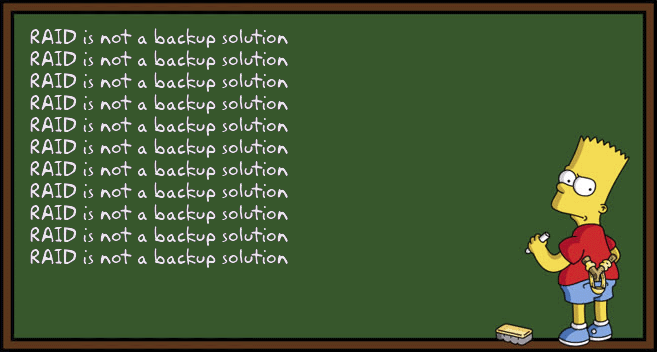
Ok, let that sink in for a moment.
There are two reasons for running RAID.
-
High availability. RAID 1 (2 drives), RAID 5 (3-16 drives), RAID 6 (4+ drives). If a drive fails, you carry on as normal, replace the drive and rebuild the new drive into the array.
-
High performance. RAID 0 stripe array (2 drives) RAID 10 mirrored stripe array (4 drives or more) You’re reading and writing from multiple drives simultaneously, so performance is higher than a single drive.
OK, different RAID types (maybe you know this already?)
RAID 1- Two drives. Data is mirrored (copied onto both). If one drive fails, you still have your data. Replace the drive, the data is copied to the new drive and carry on as normal.
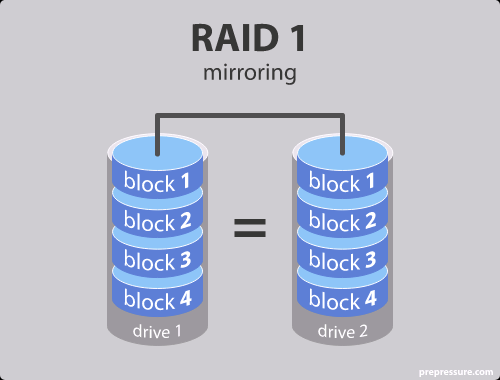
RAID 5 (striping with parity) - Data blocks are striped across the drives and on one drive a parity checksum of all the block data is written. The parity data are not written to a fixed drive, they are spread across all drives, as the drawing below shows. Using the parity data, the computer can recalculate the data of one of the other data blocks, should those data no longer be available. That means a RAID 5 array can withstand a single drive failure without losing data or access to data.
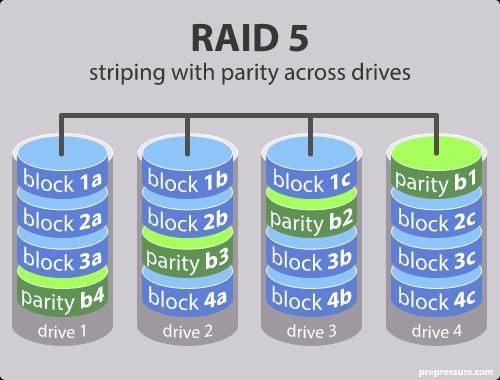
RAID 6 (striping with double parity) - RAID 6 is like RAID 5, but the parity data are written to two drives. That means it requires at least 4 drives and can withstand 2 drives dying simultaneously. The chances that two drives break down at exactly the same moment are of course very small. However, if a drive in a RAID 5 systems dies and is replaced by a new drive, it takes hours or even more than a day to rebuild the swapped drive. If another drive dies during that time, you still lose all of your data. With RAID 6, the RAID array will even survive that second failure.
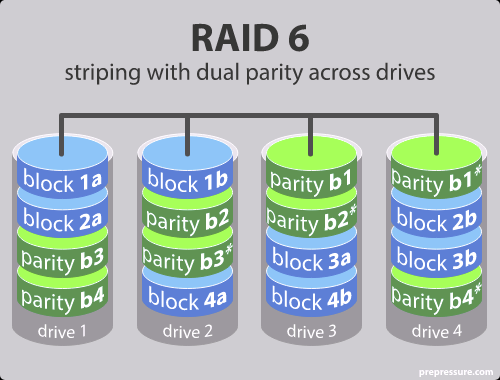
RAID 0 - (striping) In a RAID 0 system data are split up into blocks that get written across all the drives in the array. By using multiple disks (at least 2) at the same time, this offers superior I/O performance. This performance can be enhanced further by using multiple controllers, ideally one controller per disk.
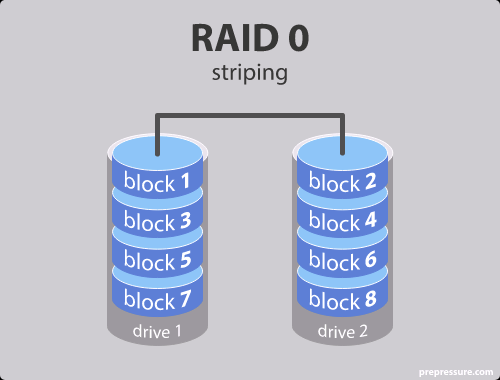
RAID 10 - (mirrored stripe, combining RAID 1 and RAID 0) It is possible to combine the advantages (and disadvantages) of RAID 0 and RAID 1 in one single system. This is a nested or hybrid RAID configuration. It provides security by mirroring all data on secondary drives while using striping across each set of drives to speed up data transfers.
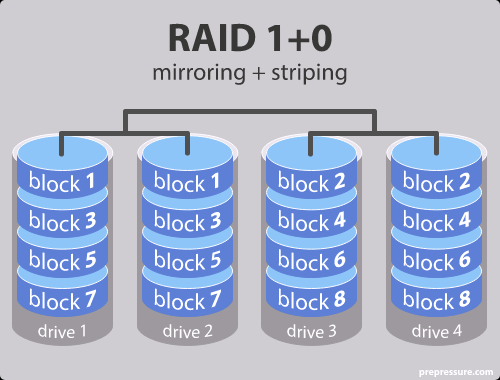
The interesting bit
RAID 0 increases performance - simultaneous reading and writing from 2 drives, so it’s twice as fast as 1 drive, but offers ZERO redundancy. Lose a drive, you lose everything.
RAID 1 gives single drive redundancy - if 1 drive fails, you still have your data on the other drive.
RAID 5 gives single drive redundancy - if 1 drive fails, you can replace it and rebuild the array maybe. Read transactions are fast as the data is split over multiple drives. Write transactions are slower than a single drive due to the parity calculations.
RAID 6 gives dual drive redundancy - up to 2 drives can fail and you can still rebuild the array maybe. Read transactions are faster as data is split over multiple drives. Write performance is up to 20% slower than RAID 5.
RAID 10 guarantees single drive redundancy - any one drive can fail and you can still rebuild the array. If a second drive fails, then it’s a game of Russian Roulette. The more drives you have, the lower the chance of a second drive failure killing the array. You have to lose the corresponding mirror drive to the initial failed drive to lose the whole array, so the more drives, the less likely this is. Performance is high - you’re reading and writing to and from multiple drives.
Now for the really interesting (scary) bit
The Achilles heel of RAID 5 and RAID 6 is the URE (unrecoverable read error) rate of your chosen drives. For consumer drives, it’s typically 1 in 10^14 (1 byte in 12.5TB), for enterprise drives, it’s typically 1 in 10^15 (1 byte in 125 TB). If a drive fails, it will be rebuilt using the parity data from the other drives, however, if during rebuild, a URE is encountered, your array will fail to rebuild and you lose the array. The bigger your array size, the higher the likelihood of an array failure during rebuild.
Another thing to note, is that if you lose a drive, your NAS will be CRIPPLED during rebuild. I experienced this with a 4-bay Synology Diskstation. The rebuild period took days and the NAS was essentially unusable during this period.
If you plan on adding 2 x 10TB drives, I would recommend going with RAID 10, you’ll end up with 20TB of storage (which is still HUGE). You gain 2 x read and write speed performance and still have 1 drive redundancy. A rebuild will be much faster. A URE during rebuild is less likely.
I would also recommend additional local backup if you can manage it and I would strongly advise you sort out an off-site backup service if you haven’t already done so. Backblaze/Backblaze B2 is robust and affordable. Recovery of your data is expensive though, which is why additional local backup is crucial.
Yes, RAID 5 will give you 30TB of storage, but the risks in my opinion outweigh the benefits.
My Synology Rackstation runs with 12 x 4TB HDDS in RAID 10 - I have 20.9 (real) TB of storage and it’s still less than half full. It reads and writes faster than an enterpise SSD.
If you want further reading, this link and the links therein are well worth reading.
Sorry for the long post, this stuff is so important and so often misunderstood.






 that I have several “extra” backups going on right now. I have most of my stuff at a friends house too…so I got backup covered. At least I hope so.
that I have several “extra” backups going on right now. I have most of my stuff at a friends house too…so I got backup covered. At least I hope so.